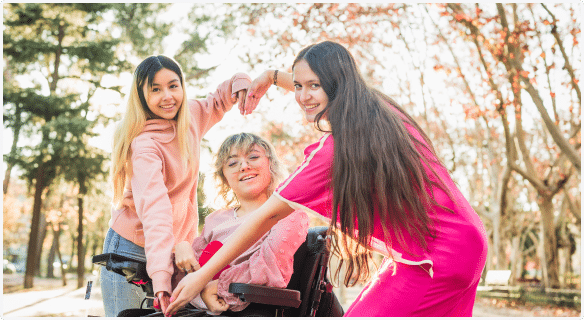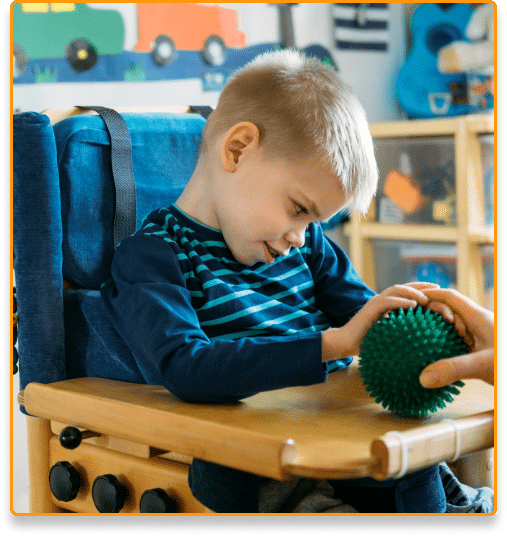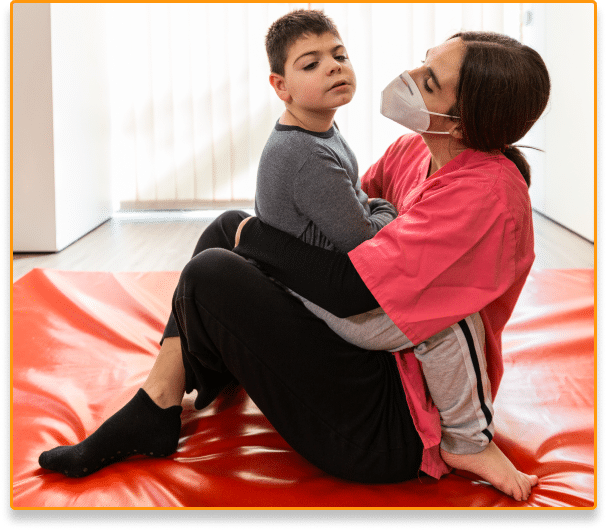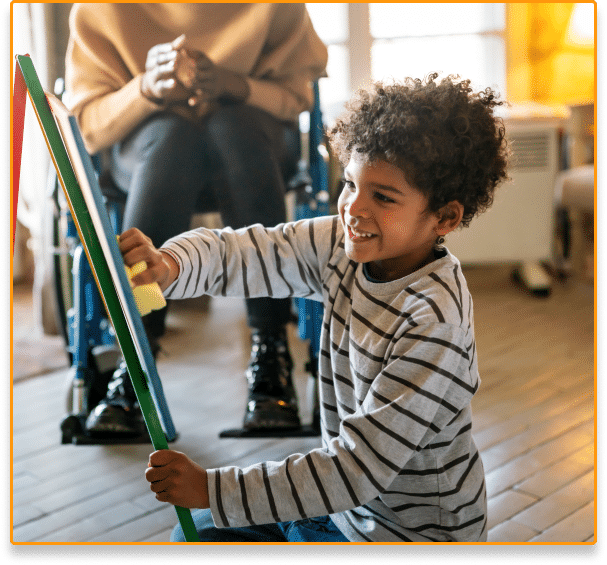CREATING INCLUSIVE SPACES FOR STUDENTS WITH CEREBRAL PALSY
Cerebral palsy is a group of disorders affecting movement, balance, and posture. It is the most common motor disability in childhood and can present unique challenges for students in the classroom. Teachers and parents can work together to help students with cerebral palsy achieve academic success and personal growth by implementing strategies to address each student’s individual needs.
Recognizing the diverse range of abilities of students with cerebral palsy will help teachers and caregivers develop appropriate accommodations and support. With the right tools, resources, and collaborative approach, educators and caregivers can help these students reach their full potential in an inclusive classroom setting. In this guide, we’ll explore practical tips and insights to help you create a welcoming learning environment that supports students with cerebral palsy and their specific needs.

TIPS FOR TEACHERS IN INCLUSIVE CLASSROOMS
Teachers should work to understand these students’ needs, create a welcoming environment, and teach strategically to help each student get the best education possible.
UNDERSTAND THE NEEDS OF STUDENTS WITH CEREBRAL PALSY
Cerebral palsy symptoms vary widely and may include stiff muscles, uncontrollable movements, poor balance and coordination, and developmental delays. Getting to know each student’s specific challenges and abilities will help teachers pivot to the needs of each individual learner.
USE STRATEGIES FOR DIFFERENTIATED INSTRUCTION AND ACCOMMODATIONS
Instructional strategies from lecturing and reading to videos, interactive apps, small group work, projects, and discussions can help meet the diverse needs of students throughout the classroom. Varying teaching methods allow all students to engage with the material in ways that suit their learning styles. Accommodations like providing extra time for assignments or modifying tasks can also help level the playing field for students with disabilities.

CREATE A WELCOMING AND INCLUSIVE CLASSROOM ENVIRONMENT
Assigning seating and strategically pairing students with disabilities with their more outgoing classmates can help encourage engagement among peers. Classrooms should be physically accessible, with ample space for mobility aids. Teachers should promptly address discriminatory language or behavior to maintain a safe and welcoming atmosphere for all students.
COLLABORATE WITH SUPPORT SERVICES AND SPECIAL EDUCATION TEAMS
A collaborative approach is the best way for educators to develop comprehensive plans to support students with cerebral palsy, ensuring they receive the necessary accommodations and services to thrive academically and socially. Regular communication with parents is also essential, as they can provide valuable insights into their child’s needs and experiences outside the classroom.


TOOLS AND RESOURCES FOR TEACHERS
There are many teaching aids and support for teachers with special education students.
ASSISTIVE TECHNOLOGY AND ADAPTIVE EQUIPMENT FOR LEARNING
Examples of helpful technology include communication devices, adapted writing tools, and specialized software. Teachers should work with occupational therapists and other professionals to identify the best tools for each student’s needs.
ACCESSIBLE CLASSROOM DESIGN AND SEATING ARRANGEMENTS
Creating an accessible classroom environment is essential for students with cerebral palsy who may have mobility challenges. Desks and other classroom furniture should be adequately spaced to allow students using wheelchairs, walkers, or other devices to navigate the room freely. Teachers should also arrange seating so students can easily see, hear, and participate in lessons.
EDUCATIONAL APPS AND SOFTWARE FOR STUDENTS WITH CEREBRAL PALSY
Many educational apps and software can support students with cerebral palsy learning needs. These tools can help with communication, writing, math, and other academic skills. To help students with cerebral palsy, teachers should explore the available options and work with technology specialists to find the most appropriate resources for their students.

COMMUNICATION AND COLLABORATION WITH CAREGIVERS AND PARENTS
Communication is key for any educational journey. When caring for patients with cerebral palsy, it helps to keep the following strategies in mind.
ESTABLISH OPEN CHANNELS OF COMMUNICATION
Regular updates on progress, challenges, and successes can help everyone work together to meet the student’s needs. Teachers should establish clear lines of communication, such as email, phone calls, or a dedicated communication app, to facilitate ongoing dialogue with parents.
SHARE PROGRESS AND ACCOMPLISHMENTS
Teachers should share progress and accomplishments with caregivers, highlighting both academic and non-academic milestones. This positive reinforcement can help foster a student’s sense of pride and get them excited to keep growing and developing.

ADDRESS CONCERNS AND PROVIDING SUPPORT
Open, honest communication is key in any educational environment, and this is particularly true for students with unique challenges like cerebral palsy. Teachers should reach out to parents when issues emerge so they can problem-solve with caregivers, who may know their children’s needs best.

ADVOCATE FOR EDUCATIONAL NEEDS AND ACCOMMODATIONS
Caregivers play an important role in fighting for their child’s educational needs and making sure they receive the necessary accommodations and support. This could mean communicating regularly with teachers, attending Individualized Education Plan meetings, and staying informed about their child’s progress and challenges. Parents should feel empowered to speak up and work collaboratively with the school to resolve concerns.

TIPS FOR CAREGIVERS AND PARENTS SUPPORTING EDUCATION AT HOME
If you’re educating your child outside of the traditional classroom environment, there are many resources available to help you give them a strong education at home.
INDIVIDUALIZED EDUCATION PLANS AND 504 PLANS
Individualized Education Plans and 504 Plans are important tools for making sure students with cerebral palsy receive the accommodations and support they need to succeed in their education, no matter what building it takes place in. Caregivers should get to know these documents and actively participate in the development and review process.
CREATE A SUPPORTIVE LEARNING ENVIRONMENT AT HOME
Caregivers can create a dedicated study space, provide access to helpful resources, and, above all, keep their kids feeling supported and encouraged. Parents can help their children develop the confidence and skills to succeed academically by modeling a positive attitude toward learning and celebrating achievements.
Frequently Asked Questions
Asking questions is the first step to helping a child with cerebral palsy learn in a safe and nurturing environment. Below are some of the most frequently asked questions on how to support these children in the classroom.
1. HOW CAN I SUPPORT A STUDENT OR CHILD WITH CEREBRAL PALSY IN A MAINSTREAM CLASSROOM?
Successfully supporting a student with cerebral palsy in a mainstream classroom involves understanding their individual needs, creating an accessible and inclusive environment, providing accommodations, and working with cerebral palsy support groups, services, and caregivers. By tailoring instruction, using assistive technology, and creating a welcoming atmosphere, teachers can help students with cerebral palsy thrive academically and socially.
2. WHAT ARE SOME EFFECTIVE TEACHING STRATEGIES FOR STUDENTS WITH CEREBRAL PALSY?
Students with cerebral palsy often work better with varied teaching methods and technologies, and teachers should make their classrooms both physically accessible and socially welcoming. As with every child’s educational journey, it takes a village, and teachers should enlist the help of support services and caregivers to understand and support each student’s individual needs.
3. HOW CAN CAREGIVERS AND PARENTS ADVOCATE FOR THEIR CHILD'S EDUCATIONAL NEEDS?
Caregivers and parents should familiarize themselves with Individualized Education Plans and 504 Plans, communicate regularly with teachers, and stay informed about their child’s progress and challenges. The goal is for parents to feel empowered to speak up and work with the school to resolve concerns.
4. ARE THERE ANY LEGAL RIGHTS AND PROTECTIONS IN PLACE FOR STUDENTS WITH CEREBRAL PALSY IN SCHOOL SETTINGS?
Fortunately, legislators have made major progress in protecting students with unique challenges and abilities, including those with cerebral palsy. The Individuals with Disabilities Education Act (IDEA) protects the right of children with disabilities to a free, quality public education in the least restrictive environment possible, including access to necessary accommodations, support services, and Individualized Education Plans.
Contact Brown & Crouppen for Your Cerebral Palsy Lawsuit
By understanding each student’s unique needs, implementing effective strategies, and providing accommodations, we can help foster academic and social success among children with cerebral palsy.
Our experienced cerebral palsy attorneys at Brown & Crouppen can help you learn more about the legal rights of individuals with cerebral palsy. If your child’s cerebral palsy was caused by medical malpractice during labor, we can also help you seek compensation through a birth injury lawsuit.
